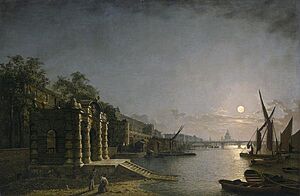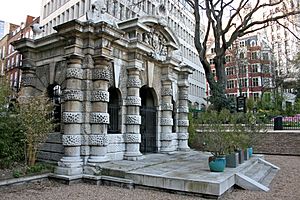York House, Strand facts for kids
York House was once a grand mansion in London, located on a famous street called the Strand. This street was the main path connecting the City of London to the Palace of Westminster, where the government met. York House was one of many large homes that lined the Strand long ago.
Contents
History of York House
From Norwich Palace to York House
York House was first built as a London home for the Bishops of Norwich, who were important church leaders. It was finished by 1237 and was known as Norwich Palace.
In 1536, King Henry VIII gave the palace to his friend, Charles Brandon, 1st Duke of Suffolk. The King traded it for another house, and the Bishop of Norwich got a new place to live.
The house became known as York House in 1556. This happened when it was given to the Archbishop of York, another important church leader. It kept this name for the rest of its time.
Famous Owners and Neighbors
York House had some famous neighbors. To its west was Suffolk House, which later became Northumberland House. To its east was Durham House.
For about 70 years, starting in 1558, York House was rented out to important government officials. These included Nicholas Bacon and Francis Bacon. They held a high position called the Lord Keeper of the Great Seal of England. This person was in charge of the King's official seal, which was used to make laws and documents official.
In the 1620s, a powerful friend of the King, George Villiers, 1st Duke of Buckingham, bought York House. After a period during the English Civil War, the house was returned to his son, George Villiers, 2nd Duke of Buckingham. In 1672, he sold the house for a lot of money to people who wanted to build new streets.
The Duke of Buckingham made a special rule when he sold the land. He wanted streets to be named after him and his titles. This is why you can still find streets like Villiers Street in London today. Other streets, like George Street and Duke Street, have since been renamed.
The Riverside Setting
The grand houses on the Strand were built there because they had direct access to the River Thames. The river was like a major highway back then, used for travel and transport.
The York Watergate is a special part of York House that still stands today. It was built around 1626 by the first Duke of Buckingham. It was meant to be a fancy landing spot for boats coming to and from the house.
Today, the York Watergate is no longer by the river. It is now about 150 meters (164 yards) away, in the Embankment Gardens. This happened because a lot of new land was created along the river when the Thames Embankment was built.
The York Watergate is one of the few remaining examples in London of the Italian style of building from the time of King Charles I. Its design is thought to have been created by famous architects like Inigo Jones.
Important Events at York House
York House was the setting for several important events.
In February 1626, a meeting called the York House Conference took place there. This meeting ended with a big disagreement between members of Parliament and the Duke of Buckingham.
In May 1627, a special show called a masque was performed at York House for the King and Queen. The Duke of Buckingham himself appeared in this show.
York House also hosted famous artists. The painter Orazio Gentileschi lived there for a time. Later, the famous painter Peter Paul Rubens stayed in the lodgings of another artist, Sir Balthazar Gerbier, during his visit to London.
The Art Collection
In 1635, a list was made of everything inside York House. This list is very helpful for historians today. It shows what a grand home looked like in the early 1600s. It also tells us about one of the most important art collections of that time.
In the "Great Chamber," there were 22 paintings and 59 Roman sculptures, many of them just heads. The "Gallery" had even more sculptures. One of the few modern sculptures at York House was Samson and a Philistine by Giambologna. This sculpture was a gift from King Philip IV of Spain to King Charles I, who then gave it to his friend, the Duke of Buckingham.
Legacy of York House
The name "York House" was used again in the early 1800s for a new, very grand house built near St James's Palace. This house was for the Duke of York, who was the brother of King George IV. When the Duke died, the house was still unfinished. It was later completed and became known as Lancaster House.
Today, a business building in London also carries the name York House.
The York Watergate is even mentioned in a song! The progressive rock band Big Big Train wrote a song called "London Plane" about it. The song tells the story of a nearby tree that was a young plant when the Watergate was built in 1626. It imagines all the history the tree might have seen over the years.



